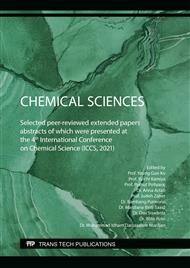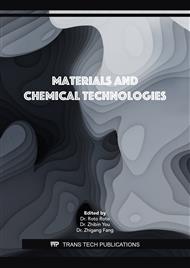[1]
R.J. Geider, E.H. Delucia, P.G. Falkowski, A.C. Finzi, J.P. Grime, J. Grace, T.M. Kana, J. La Roche, S.P. Long, B.A. Osborne, T. Platt, I.C. Prentice, J.A. Raven, W.H. Schlesinger, V. Smetacek, V. Struart, S. Sathyendranath, R.B. Thomas, T.C. Vofelmann, P. Williams, F.I. Woodward, Primary productivity of planet earth: biological determinants and physical constraints in terrestrial and aquatic habitats, Global Change Biol. 7 (2001) 849–882.
DOI: 10.1046/j.1365-2486.2001.00448.x
Google Scholar
[2]
M. Ahmed, C.K. Chong, H. Cesar, Economic Evaluation and Policy Priorities for Sustainable Management of Coral Reefs, WorldFish Centre, Penang, (2004).
Google Scholar
[3]
S. McMellor, D.J. Smith, Coral Reefs of the Wakatobi: Abundance and biodiversity, in: J. Clifton, R.K.F. Unsworth, D.J. Smith (Eds.), Marine Research and Conservation in the Coral Triangle–The Wakatobi National Park, Nova Science Publisher, New York, 2010, p.19–33.
DOI: 10.1007/s00338-002-0250-9
Google Scholar
[4]
R.W.M. Van Soest, N. Boury-Esnault, J. Vacelet, M. Dohrmann, D. Erpenbeck, N.J. de Voogd, N. Santodomingo, B. Vanhoorne, M. Kelly, J.N.A. Hooper, Global Diversity of sponges (Porifera), PLoS ONE 7 (2012) e35105.
DOI: 10.1371/journal.pone.0035105
Google Scholar
[5]
M.J. Uriz, D. Rosell, D. Martin, The sponge population of the Cabrera Archipelago (Balearic Islands): Characteristics, distribution, and abundance of the most representative species, Mar. Ecol. 13 (1992) 101–117.
DOI: 10.1111/j.1439-0485.1992.tb00343.x
Google Scholar
[6]
G.M. Cameron, B.L. Stapleton, S.M. Simonsen, D.J. Brecknell, M.J. Garson, New sesquiterpene and brominated metabolites from the tropical marine sponge Dysidea sp., Tetrahedron 56 (2000), 5247–5252.
DOI: 10.1016/s0040-4020(00)00434-8
Google Scholar
[7]
N. Hanif, J. Tanaka, A. Setiawan, A. Trianto, N.J. de Voogd, A. Murni, C. Tanaka, T. Higa, Polybrominated diphenyl ethers from the Indonesian sponge Lamellodysidea herbacea, J. Nat. Prod. 70 (2007), 432–435.
DOI: 10.1021/np0605081
Google Scholar
[8]
A.D. Patil, A.J. Freyer, L. Killmer, P. Offen, B. Carte, A.J. Jurewicz, R.K. Johnson, Frondosins, five new sesquiterpene hydroquinone derivatives with novel skeleton from the sponge Dysidea frondosa: Inhibitors of interleukin-8 receptors, Tetrahedron 53 (1997), 5047–5060.
DOI: 10.1016/s0040-4020(97)00205-6
Google Scholar
[9]
Y.K. Hallock, J.H. Cardellina, M.R. Boyd, (-)-Frondosins A and D, HIV-Inhibitory sesquiterpene hydroquinone derivatives from Euryspongia sp., Nat. Prod. Lett. 11 (1998) 153–160.
DOI: 10.1080/10575639808041212
Google Scholar
[10]
Y.H. Gui, L. Liu, W. Wu, Y. Zhang, Z.L. Jia, Y.P. Shi, H.T. Kong, K.C. Liu, W.H. Jiao, H.W. Lin, Discovery of nitrogenous sesquiterpene quinone derivates from sponge Dysidea Septosa with anti-inflammatory activity in vivo zebrafish model, Bioorg. Chem. 94 (2020) 103435.
DOI: 10.1016/j.bioorg.2019.103435
Google Scholar
[11]
P.V. Kiem, N.X. Nhiem, B.H. Tai, H.L.T. Anh, D.T.T. Hang, N.T. Cuc, L.T. Huyen, N.H. Nam, P.H. Yen, D.C. Thung, C.V. Minh, Bis-sesquiterpene from the marine sponge Dysidea fragilis, Nat. Prod. Commun. 11 (2016) 439–441.
DOI: 10.1177/1934578x1601100403
Google Scholar
[12]
N.K. Utkina, V.A. Danisenko, Tauroarenarones A and B, new taurine-containing meroterpenoids from the marine sponge Dysidea sp., Nat. Prod. Commun. 9 (2014) 757–758.
DOI: 10.1177/1934578x1400900606
Google Scholar
[13]
E. Perez-Garcia, E. Zubia, M.J. Ortega, J.L. Carballo, Merosesquiterpenes from two sponges of The Genus Dysidea, J. Nat. Prod. 68 (2016) 653–658.
DOI: 10.1021/np040237z
Google Scholar
[14]
U. Hentschel, K.M. Usher, M.W. Taylor, Marine sponges as microbial fermenters, FEMS Microbiol. Ecol. 55 (2006) 167–177.
DOI: 10.1111/j.1574-6941.2005.00046.x
Google Scholar
[15]
M.F. Mehbub, J. Lei, C. Franco, W. Zhang, Marine sponge derived natural products between 2001 and 2010: Trends and opportunities for discovery of bioactives, Mar. Drugs 12 (2014) 4539–4577.
DOI: 10.3390/md12084539
Google Scholar
[16]
J.R. Pawlik, G. McFall, S. Zea, Does the odor from sponges of the genus Ircinia protect them from fish predators?, J. Chem. Ecol. 28 (2002) 1103–1115.
Google Scholar
[17]
B.N. Meyer, N.R. Ferrigni, J.E. Putnam, L.B. Jacobsen, D.E. Nichols, J.L. McLaughlin, Brine shrimp: A convenient general bioassay for active plant constituents, Planta Med. 45 (1982) 31–34.
DOI: 10.1055/s-2007-971236
Google Scholar
[18]
C. Jimènez, E. Quińoã, M. Adamczeski, L.M. Hunter, P. Crews, Novel sponge-derived amino acids. 12. Tryptophan-derived pigments and accompanying sesterterpenes from Fascalysinopsis reticulata, J. Org. Chem. 56 (1991) 3403–3410.
DOI: 10.1021/jo00010a041
Google Scholar
[19]
X. Yang, M.C. Kang, K.W. Lee, S.M. Kang, W.W. Lee, Y.J. Jeon, Antioxidant activity and cell protective effect of loliolide isolated from Sargassum ringgoldianum subsp. coreanum, Algae 26 (2011) 201–208.
DOI: 10.4490/algae.2011.26.2.201
Google Scholar
[20]
R. Hodges, A.L. Porte, The structure of loliolide: A terpene from Lolium perenne, Tetrahedron 20 (1964) 1463–1467.
DOI: 10.1016/s0040-4020(01)99140-9
Google Scholar
[21]
H. Martin-Rivilla, F.J. Gutierres-Manero, A. Gradillas, M.O.P. Navarro, G. Andrade, J.A. Lucas, Identifying the compound of the metabolic elicitors of Pseudomonas flourescens N 21.4 responsible for their ability to induce plant resistance, Plants 9 (2020) 1020.
DOI: 10.3390/plants9081020
Google Scholar



